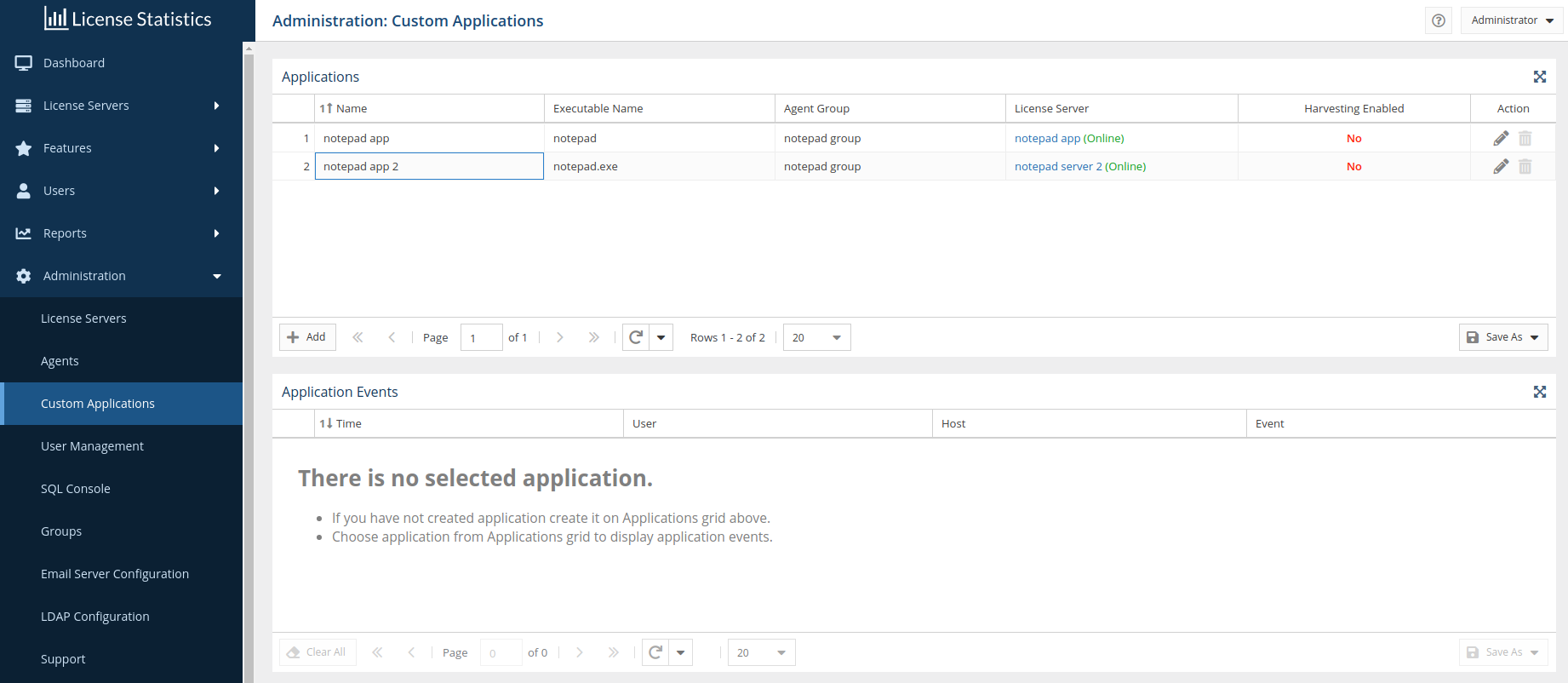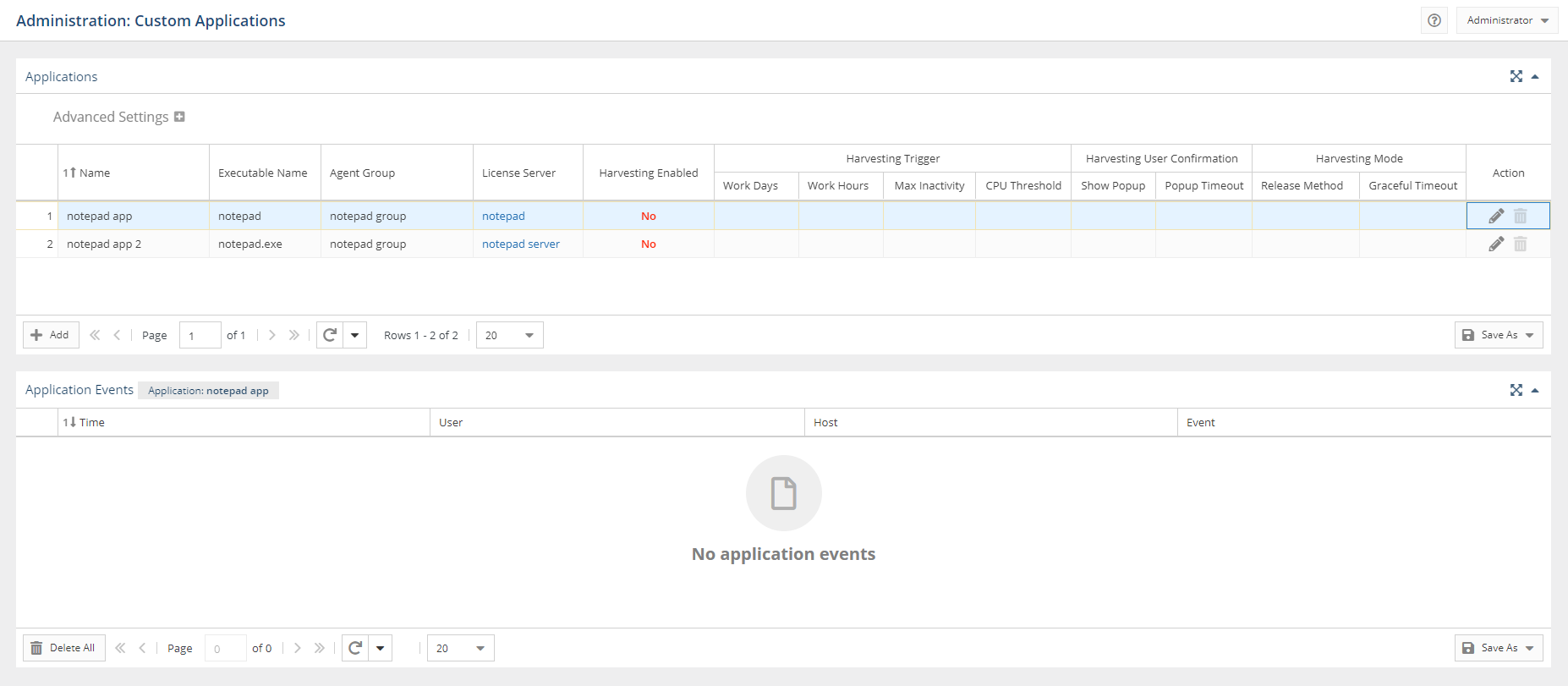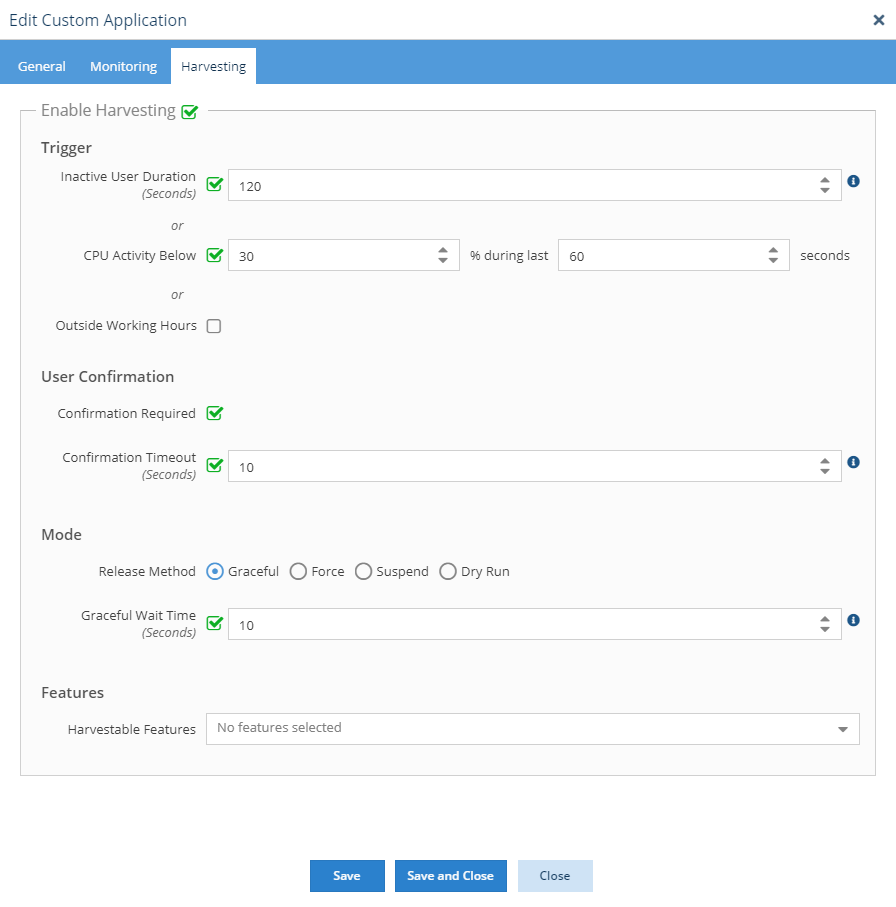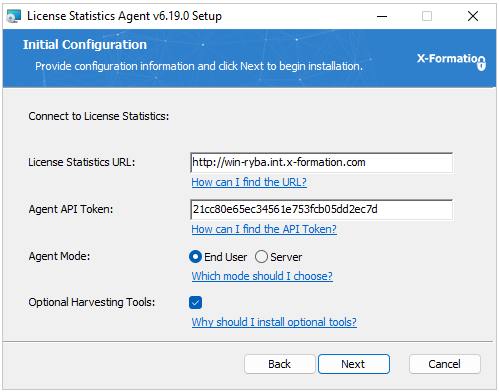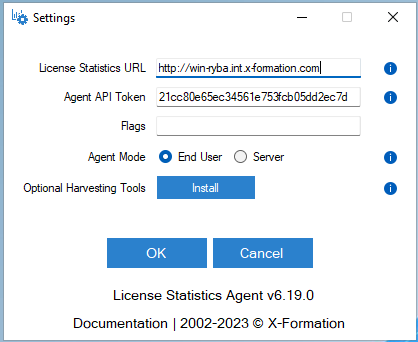...
The information on this page refers to License Statistics v6.18 20 and newer, which redesigned the Enable Harvesting area of the Harvesting tabadded a new "Dry Run" option to the Release Methods. If you are using an earlier version, please refer to the documentation for earlier versions. |
To use License Harvesting, you must:
...
- Select Custom Applications under the Administration section in the left pane.
- Click the Add button located in the bottom left corner of the Applications grid to add a new application, or click Edit to edit an existing application. The Custom Application form opens.
- If you are adding a new application, see the instructions on configuring the new application before proceeding to the next step. If you are editing an existing application, continue to the next step.
- Go to the Harvesting tab and toggle on Enable Harvesting.
Complete the application configuration settings, as described in the table belownext section.
After the application is configured, click Save at the bottom of the page. You return to the Administration: License Harvesting page, where you will see that License Harvesting is active for the application by looking in the Harvesting Enabled column for the application.
Application configuration settings
The settings for configuring an application for License Harvesting include the following.
| Setting | Description |
|---|---|
| Trigger (License Harvesting will be triggered when any of the enabled conditions are met. Each setting may be used alone or together.) | |
| Inactive User Duration | When toggled on, the maximum amount of time (in seconds) that the application is allowed to be idle (the user is not actively using the application), after which the License Harvesting procedure will begin for that application. You may either type the number of seconds, or use the increase/decrease arrows to adjust the number of seconds. |
| CPU Activity Below | When toggled on, the maximum percentage that the CPU activity is allowed to drop down during the specified duration (in seconds), after which the License Harvesting procedure will begin for that application. |
| Outside Working Hours | Days Days of the week that the application is available for use. For example, if you want to exclude weekend days from the times that the application can be used, you would toggle off Saturday and Sunday. |
Hours Time range (24-hour clock) that the application is available for use. For example, if you want to limit the hours of usage from 7 a.m. to 7 p.m., you would enter From: 07:00 To: 19:00. You may either type the time or select it from the drop-down list. | |
| User Confirmation | |
| Confirmation Required | When toggled on, when License Harvesting detects that the application is in an idle state, a confirmation message will be sent to the end-user asking them to confirm closing the application. When this option is not toggled on, the application will be closed immediately with no alert to the end-user. |
| Confirmation Timeout | This option may be toggled on only when Confirmation Required has been toggled on. When this option is toggled on, it sets the time (in seconds) to display the confirmation message to the user, after which License Harvesting will automatically close or suspend the application. When this option is not toggled on, the user confirmation alert will remain on the end-user's machine until the end-user dismisses the alert. |
| Mode | |
| Release Method | Toggle to |
select the desired release method to use when releasing the application license due to idle state detection. Release methods include the following:
| |||
| Graceful Wait Time | Applies only when using Graceful release method. When toggled on, the time (in seconds) to wait for unsaved state questions or confirmations to be resolved, after which the application will be forced to close. When not toggled on, the application will remain open indefinitely if there are unsaved state questions or confirmations needed. | ||
| Features | |||
| Harvestable Features | Allows remote session closing for features of applications configured for License Harvesting. When a feature has been enabled for harvesting, after License Harvesting closes an application on the end-user host, License Statistics will automatically force the session to release on the corresponding license server and return the license to the available pool.
| ||
Configuration scenarios
The following table illustrates combinations of configuration settings that serve end-user experiences ranging from the least to most aggressive handling of license harvesting.
- The most gentle end-user experience (intensity level 1) uses the Graceful release method combined with confirmations that have indefinite wait timesDry Run method without confirmation.
- The most abrupt end-user experience (intensity level 814) employs the Force release method, which does not allow for any user confirmation/timeout periods.
Intensity | User Confirmation | User Confirmation Timeout | Dry Run Method | Suspend Release Method | Graceful Release Method | Graceful Timeout | Force Release Method |
|---|---|---|---|---|---|---|---|
1 | - | - | - | - | - | ||
2 | - | - | - | - | |||
3 | - | - | - | - | |||
4 | - | - | - | - | |||
5 | - | - | - | - | |||
6 | - | - | - | - | - | ||
7 | - | - | - |
8 | - | - | - |
|---|
| 9 | - | - | - |
|---|
10 | - | - | - | - |
|---|
11 | - | - | - | - |
|---|
| 12 | - | - | - | - |
|---|
13 | - | - | - | - |
|---|
14 | - | - | - | - | - |
|---|
= enabled
= disabled - = not applicable
Considerations for using the Dry Run method
The Dry Run method is the least intense method, and is particularly useful for the following:
- Testing how License Harvesting works with specific applications without closing those applications
- With confirmations disabled, you can monitor how end-users are using particular applications without sending alerts or taking any other actions that disrupt their work
- With confirmations enabled, you can notify end-users that they have idle applications running, and allow the users the choice to close the application, without taking any automatic action to close it
Considerations for using Graceful timeout
The Graceful release method is similar to closing the application using its Close button. For most applications, the Graceful release method results in an indefinite wait for the user to respond to a prompt to close the application. However, some applications may handle the request from License Harvester differently than the Close button, any may perform custom operations or fail to save the current state. Since License Harvester is set up for all applications instead of individual applications (and therefore License Statistics is not able to monitor how individual applications behave), be sure to test results for each application being monitored and apply the correct intensity level for your needs.
...
When a feature has been enabled for harvesting, after License Harvesting closes an application on the end-user host, License Statistics will automatically force the session to release on the corresponding license server and return the license to the available pool.
| Anchor | ||||
|---|---|---|---|---|
|
To use the Suspend mode for License Harvesting, the following requirements must be met:
- The License Statistics Agent version must be v6.19 or newer. If the Agent version is older than v6.19, the Suspend configuration won't be applied and no harvesting will be used on those hosts.
- Agent must have Optional Harvesting Tools installed.
Optional Harvesting Tools installation
The tools are installed by default when using the installer for installation or update. Make sure Optional Harvesting Tools is toggled on in the Initial Configuration pane of the installation:
Alternatively, you can install the Optional Harvesting Tools at any time using License Statistics Agent Manager:
For instructions on installing the Optional Harvesting Tools from a command line, see Installing and configuring License Statistics Agent.
Results of installing Optional Harvesting Tools
Installing the Optional Harvesting Tools will automatically download the required PSTools libraries from the Microsoft website (these libraries cannot be included directly in License Statistics due to licensing restrictions; however, they are free to use).
Agent will use the PSSuspend.exe application to execute the operation.
